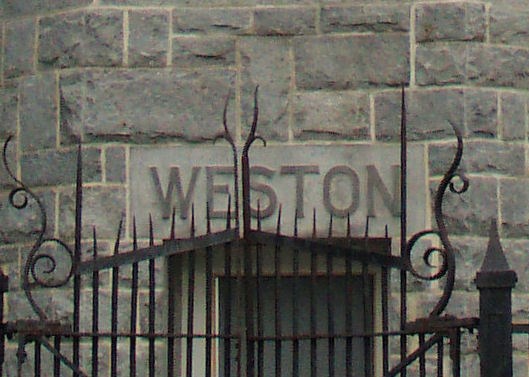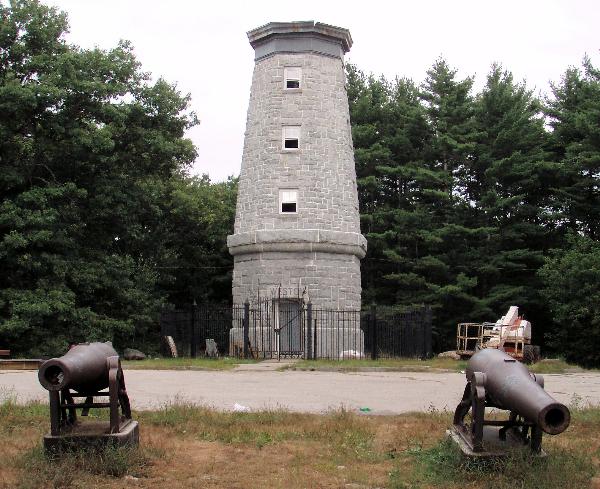
These two U.S. Navy cannons are Nos. 223 and 225 manufactured by the Cyrus Alger Co. of Boston, sometime after 1840, or 1855. Their weights, respectively are 4522 lbs. and 4523 lbs. (See photo gallery for markings). These are mounted about 50' in front of the observatory beyond the edge of the circular stoned paved area, with the iron bases resting directly on the bare ground, facing southwest overlooking the city of Manchester, New Hampshire.
The Weston Observatory was built in 1887 as an observation tower for the citizens of Manchester, New Hampshire. The 66-foot-tall tower is built of granite and brick-arched window wells are a solid four feet deep.
Constructed in 1896-97, the building is named for former Manchester mayor, James A. Weston, who left the city $5,000 to build an observatory for "the advancement of science, for educational purposes, and for the use, enjoyment, benefit, and mental improvement of the inhabitants of the city of Manchester." The man who grew up on a local farm became the first native to serve as both mayor (four times) and governor (two terms). When you turn on your tap, you can thank him for constructing the city water works. His home was on the grounds of what is now Wagner Park, fitting for the mayor who also created an extensive parks and cemetery beautification program.

The 66-foot-tall tower is built of granite and brick-arched window wells are a solid four feet deep. Spiral stairs made of steel decking with iron handrails lead you in circles up to the roof, where you step out into the breeze onto a small observation deck.
The view from the top is spectacular. You can see as far as Mt. Chocorua and Mt. Kearsarge. Tall pines have shot up in the area that once was a picnic field to obscure the view of Mt. Monadnock, but the panorama of the Merrimack Valley to the west is thick with green all the way to the rolling hills past Joe English Hill in New Boston.
In its early years, the observatory was a popular destination at the end of the Bridge Street trolley line, where people came for picnics and special events like Easter sunrise service. After air raid wardens used it as a spotting post in World War II, it fell into disrepair and was closed for 30 years.
As the city wrecking ball moved in, volunteers led by Louis-Israel Martel rallied to restore the building, which was rededicated 80 years after its initial opening, on Sept. 11, 1977. Visitors were delighted to climb up to the observation deck to see a view of the city they hadn't seen in 30 years. It was placed on the National Register of Historic Places in 1975.
Although one can still walk to the observatory, the access road is closed and the tower itself is locked. There is also access from Derryfield Park below.
The best short biography of Weston comes from
Cow Hampshire.
"James Adams Weston was born 27 August 1827 on the “old Weston farm” in Manchester NH.
He was the youngest of five children. He attended two local academies, and had the education typical of the sons of farmers. He taught school for two years, and during that time he became self-taught in civil engineering. This talent for engineering became obvious and starting in 1846 he was assistant, and later chief engineer for many of the local railroad projects including that of the Concord, Manchester and Lawrence, Manchester and Candia, Hooksett Branch, and Suncook Valley Railroads.
Beginning in 1862 he ran twice for mayor of Manchester and lost. Not giving up, In 1867 he again accepted the nomination, and was elected mayor by a handsome majority. In January of 1868 he began his term as mayor. He was re-elected mayor in 1870, 1871, and in 1874-5. The major accomplishments as mayor focused on the city's infrastructure. His administration made improvements in the city's sewer system, sidewalks, public commons, and water supply. He was the first to recommend the erection of a soldier's monument, selecting a design and superintending the work. He was instrumental in securing Stark Park as a historic and public place. He also secured the Weston Reservoir.
He was elected Governor of New Hampshire and inaugurated on 14 June 1871. His portrait can be viewed in the New Hampshire State House, on the second floor. Weston retired from politics but kept many business interests including banking, the railroad, and insurance companies. He had been a member of the Masonic fraternity since 1861 and received all the grades, including the orders of knighthood."